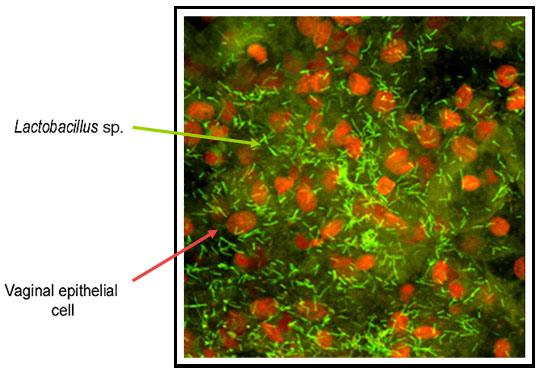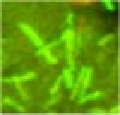Lactobacillus jensenii: Difference between revisions
| Line 64: | Line 64: | ||
[http://www.pubmedcentral.nih.gov/picrender.fcgi?artid=1716961&blobtype=pdf Dean Hamer, Louise McHugh, Margaret McKinney, Chris Richards,Kevin Schully, Laurel Lagenaur and Srinivas Rao. 2006. "Live microbial microbicides for HIV 2006". International Meeting of The Institute of Human Virology Baltimore, USA. 17–21 November, 2006 ] | [http://www.pubmedcentral.nih.gov/picrender.fcgi?artid=1716961&blobtype=pdf Dean Hamer, Louise McHugh, Margaret McKinney, Chris Richards,Kevin Schully, Laurel Lagenaur and Srinivas Rao. 2006. "Live microbial microbicides for HIV 2006". International Meeting of The Institute of Human Virology Baltimore, USA. 17–21 November, 2006 ] | ||
[http://iai.asm.org/cgi/content/full/70/12/7169 Diane C. St. Amant,Iris E. Valentin-Bon, and Ann E. Jerse. 2002. "Inhibition of Neisseria gonorrhoeae by Lactobacillus Species That Are Commonly Isolated from the Female Genital Tract". Infection and Immunity, December 2002, p. 7169-7171, Vol. 70, No. 12] | |||
Edited by Frances Cho, student of Rachel Larsen at UCSD. | Edited by Frances Cho, student of Rachel Larsen at UCSD. | ||
Revision as of 03:09, 29 April 2007

Classification
Higher order taxa
Bacteria; Firmicutes; Bacilli; Lactobacillales; Lactobacillaceae; Lactobacillus
Genus
Lactobacillus jensenii
|
NCBI: Taxonomy |
Description and significance
From the genus Lactobacillus, L. jensenii is a "facultatively anaerobic, catalase-negative, none-spore-forming, Gram Positive, rod-shaped" bacteria. This particular strain is one of the predominant species(along with Lactobacillus crispatus) found in the female lower genital tract. Because this bacteria is a natural vaginal strain, this novel microorganism has become a special interest to HIV/AIDS researchers who are looking for a shuttle of HIV inhibitor cyanovirin-N (CV-N) that they can genetically modify. So, to facilitate efficient expression of CV-N by this bacterium, L. jensenii 1153 genome has been sequenced by shotgun approach.

Genome structure
Describe the size and content of the genome. How many chromosomes? Circular or linear? Other interesting features? What is known about its sequence? Does it have any plasmids? Are they important to the organism's lifestyle?
L. jensenii 1153 genome has been sequenced.
Cell structure and metabolism
Describe any interesting features and/or cell structures; how it gains energy; what important molecules it produces.
L. jensenii could be differentiated from other species of lactobacilli by the following combination of characteristics: production of only D-lactate, hydrolysis of arginine, and fermentation of cellobiose, galactose, and ribose, but not of lactose.
Ecology
Describe any interactions with other organisms (included eukaryotes), contributions to the environment, effect on environment, etc.
Pathology
How does this organism cause disease? Human, animal, plant hosts? Virulence factors, as well as patient symptoms.
So far, its pathogenicity for men is unknown.
Application to Biotechnology
Does this organism produce any useful compounds or enzymes? What are they and how are they used?
Current Research
Some of the recent researches on Lactobacillus jensenii:
Live Microbial Microbicides for HIV
Lactobacillus jensenii has been genetically modified to produce and secrete peptide that prevents fusion with HIV using S-protein layer secretion pathway. Genetically engineered L. jensenii was able to proliferate in the vaginas of estrus phase mice and maques as well as secrete this anti-HIV peptide. This may be an inexpensive and convenient way to block HIV infection and/or replication.
Inhibition of Neisseria gonorrhoeae by Lactobacillus Species That Are Commonly Isolated from the Female Genital Tract
Four strains (Lactobacillus jensenii, Lactobacillus crispatus, Lactobacillus acidophilus, and Lactobacillus gasseri) of Lactobacillus were studied because of past reports of the possible link between high colonization of Lactobacillus and low risk of gonorrhea. In this experiment, Neisseria species or Escherichia coli strains serving as target organisms and four clinical isolates of N. gonorrhoeae were added at different pH on plates containing heart infusion agar and saline solutions of respective Lactobacillus strains. All four strains were able to inhibit the gonococcal strains at low pH while L. jensenii and L. crispatus was also able to inhibit N. gonnorrhoeae at neutral pH. None of them were able to inhibit E. coli strains, though L. jensenni was able to inhibit Neisseria cinerea. On the quantitative scale of the assay, L. jensenii were particularly most resistant to N. gonorrhoeae in the four strains. The strains were able to use H2O2 as mediator to resist the infection. The paper was able to conclude that the presence of L. jensenii and L. crispatus helps reduce risk of gonorrhoeae.
References
Edited by Frances Cho, student of Rachel Larsen at UCSD.
